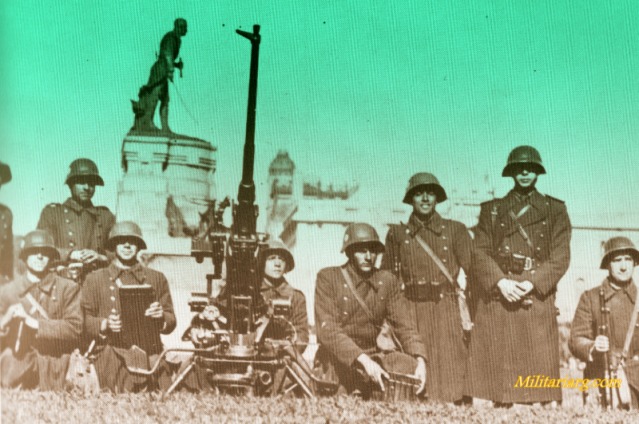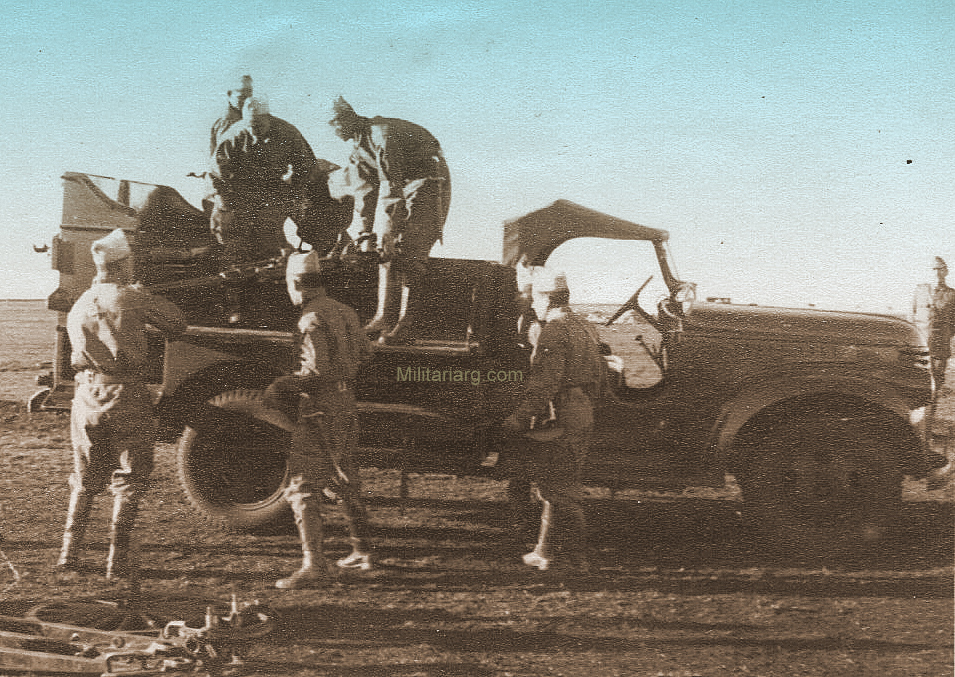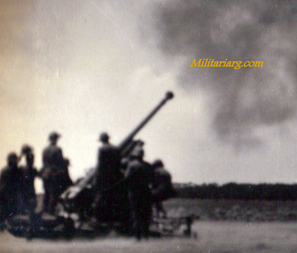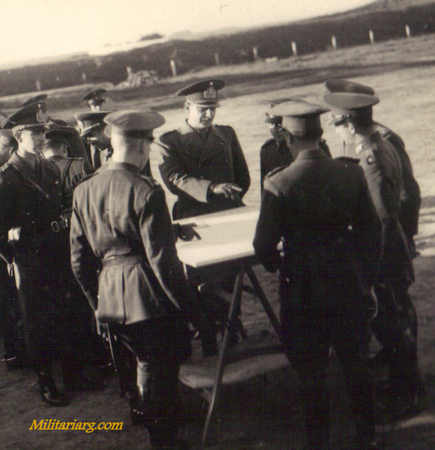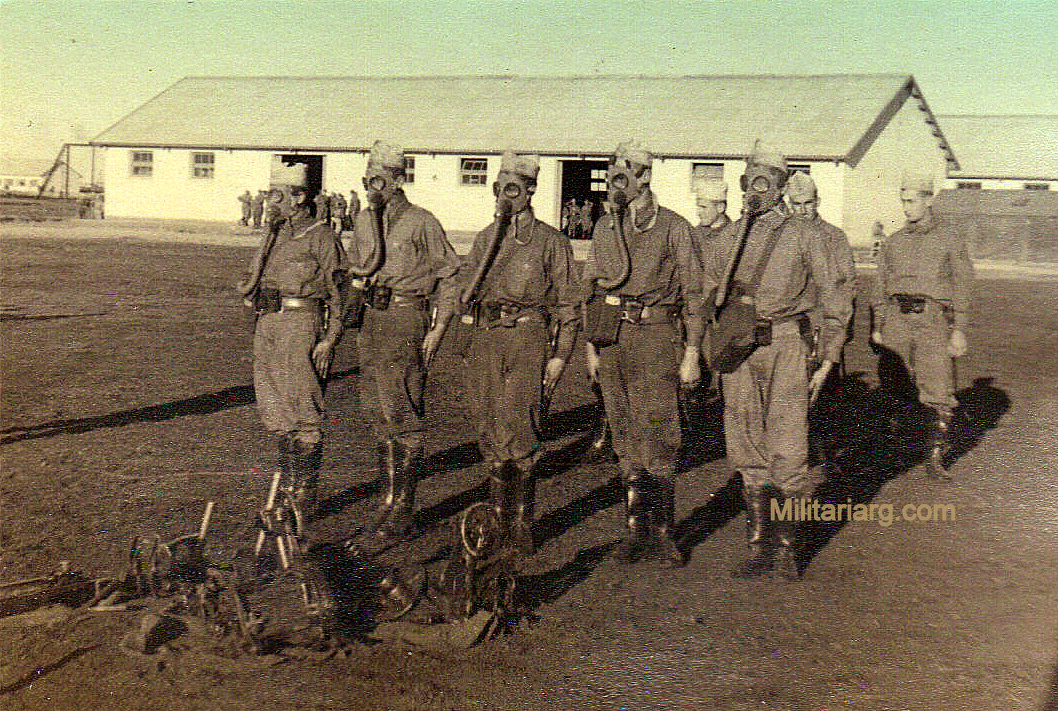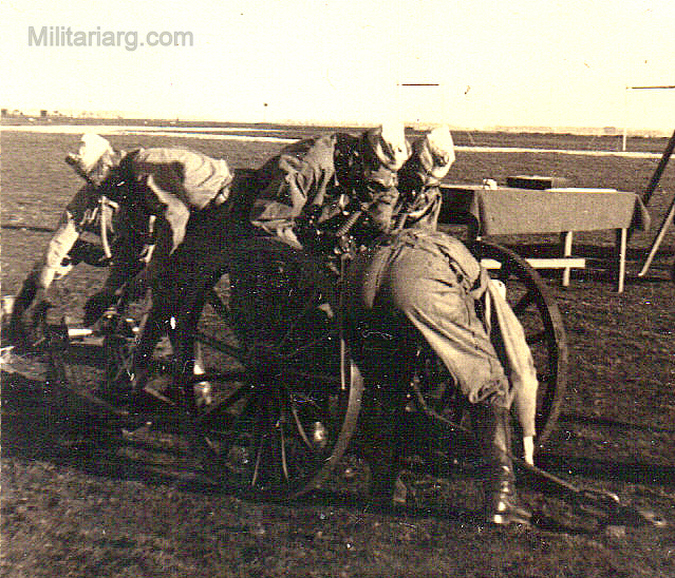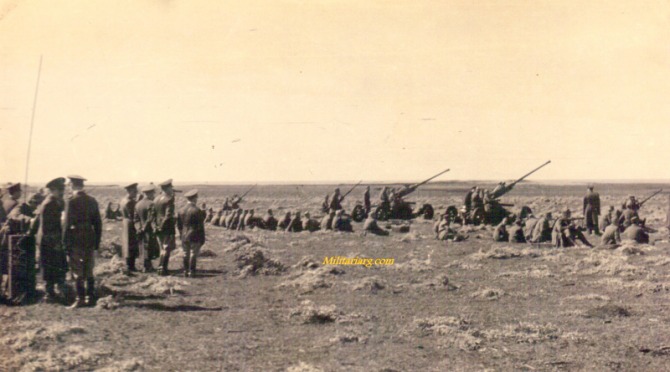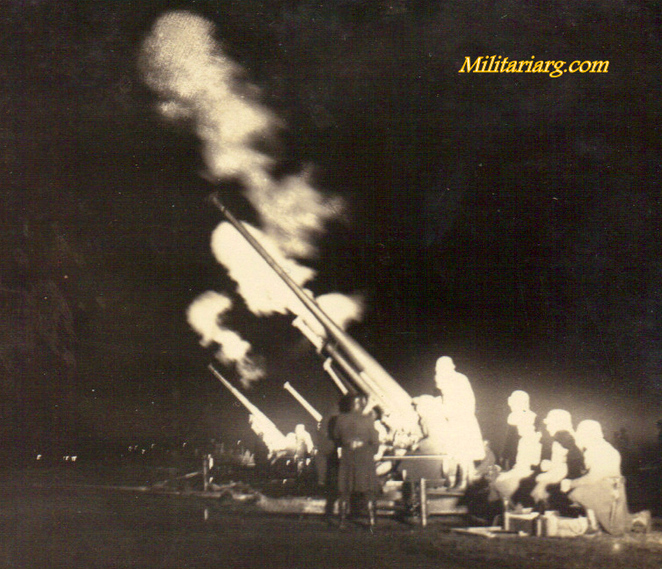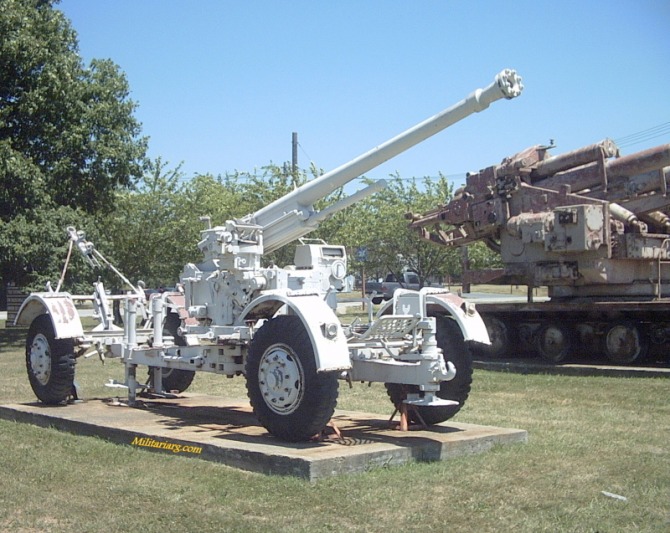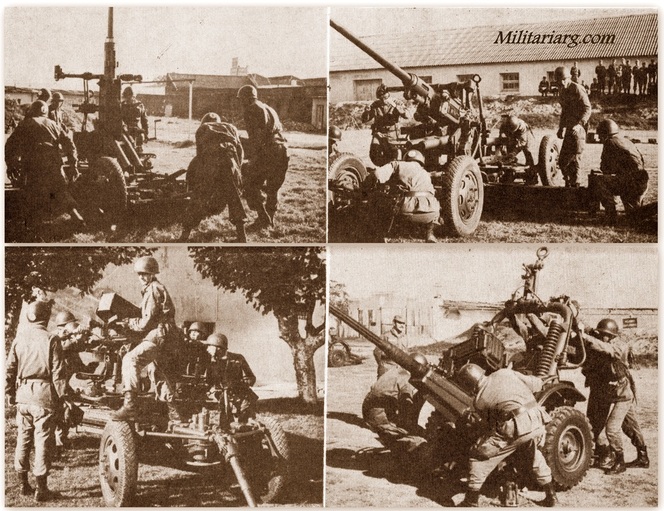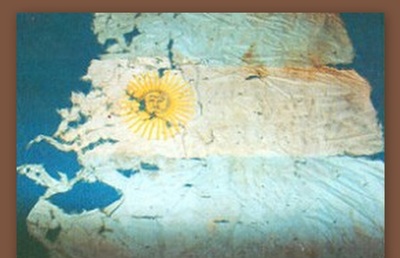Swiss 20mm AA Oerlikon. Photo from "The Army & Politics in Argentina 1928-1945" by Robert A. Potash, a Professor of History at the University of Massachusetts. The Oerlikon originated in Germany in 1917 and was known as the "Becker Cannon" for its designer Reinhold Becker. The Treaty of Versailles meant that Germany could no longer produce such weapons so the patents went to the Swiss company SEMAG (Seebach Maschinenbau Aktien Gesellschaft). Eventually the patent for the cannon was bought by the Oerlikon Machine Tool company which made improvments on the already strong design. It has a blow-back design that is easily mounted on aircraft, trucks, trailers or grounded. They were used all over the world. Oerlikon Switzerland is now: Rheinmetall Defense Air Systems (De Tec AG).
Thornycroft 3 ton lorry with Prototype AA Krupp gun Model 1927 (type WWI Balloon destroyer). Argentine anti-aircraft developed from a Krupp 75mm.
Caras y Caretas 1935.
DCA, Type "A3" RSW truck/half-track w/Oerlikon 20mm L70 M1938 DCA (AAA) gun.
This photo shows a motorized formation of an anti-air group with Oerlikon 20 mm M23 A.A., possibly from pieces obtained from the Swiss in 1938. The crew is transported over commercial Chevys weighing 1.5 tons (that may be Model 1941/42) similar to the Chevys used by the LRDG commandos during operations behind enemy lines in North Africa. The LRDG was equipped with this type of 6 cylinder vehicle with provisions for the Model 35 20 mm Breda machine gun, captured in large quantities during Operation Compass in December 1940. Note the lateral straps made of canvas to close the doors like the M38, Jeep, Willy, Bantam, M151 Mutt and other varieties.
Anti-Aircraft Artillery
20mm L70 M1938 (Oerlikon).
76.5mm L50 M1928 (Skoda).
40mm L60 M1938 (Bofors).
After the Great War of 1914-1918 and lessons learned. The high command of artillery consider updating the old doctrines and equipment. This modernization was based on topographic features, possibilities and needs.On 1 January 1925 creates the "SchoolsWeapons "on the former" School Shooting ".
This old facility was conveniently extended to test new and more powerful artillery pieces. The School of Artillery became a laboratory test of the most diverse sizes and models of artillery that were coming into the country with the purpose of testing on organic field experiences and tactics. Hence the great variety of models are listed but not in service.
Within this program of improvement of artillery of various types of artillery. There were separate courses for leaders (lieutenant colonels and majors). Training courses for captains and lieutenants.
For the decade of 30, the artillery had already reached a place of importance. Artillery School became the larger unit of the army, reaching itseffective: 62 Chieff Officers, and similar officers, 115 NCOs, 912 soldiers, 38 petty officers and 3 civilian employees, giving a total of 1130 men.
It was organized into the following units:
1 "The Regiment" 6 Artillery, divided into two groups.
(Light Artillery) One of these is an artillerylight of two batteries of guns
75mm and a battery of 105mm light howitzers.
(Heavy Artillery) with a heavy artillery gun battery of 130mm (a mechanical
drive) and a battery 150mm howitzer.
2 "The Recognition Group 1. Special unit, very modern, made following
theteachings of the Great World War.
Comprises the following subunits:
A) A Meteorological Section. Task of calculating the effects of weather exerted on the projectile during its entire trajectory. They then made the necessary corrections.
B) An optical battery. With which it can accurately locate enemy artillery by its own fire. Also fix the firing of their own artillery.
C) An acoustic drum. Which solves the two above problems. Based in the sound produced by the explosions of the enemy guns or exploding projectiles of artillery themselves.
D) A Trigonometrical Battery. Its mission is to set exactly on a plane, the positions of optical and acoustic measurement and provide the artillery, the necessary foundation for shooting unattended.
3 "heavy antiaircraft artillery group. Created in early 30s to complete the artillery system of modern warfare:
A battery of antiaircraft guns.
A battery of auditory detection.
A battery of searchlights.
A battery command with predictors. The predictor a calculating machine rankings for beating an aerial target is a system that transmitted electrically to the artillery the exact position of the target. The artillery is the target in a mechanical and automatic. The predictor also was known as "Table of shooting mechanics.
"For the instruction of officers and troops. The development of the courses. The school had a very complete meteorological observatory. part of the Department of Geophysics, Meteorology and Hydrology.
Provided with a station transmitting and receiving communications. With the most diverse era equipment, radios, telephones, telegraphy, Flash and Morse apparati. There was a classroom or simulated shot shooting simulator. Sand tables provided with devicespower to represent shelling. And an apparatus for shooting, on the same sand tables.
Source: Adolfo Spindola. Caras y Caretas 1933.
This old facility was conveniently extended to test new and more powerful artillery pieces. The School of Artillery became a laboratory test of the most diverse sizes and models of artillery that were coming into the country with the purpose of testing on organic field experiences and tactics. Hence the great variety of models are listed but not in service.
Within this program of improvement of artillery of various types of artillery. There were separate courses for leaders (lieutenant colonels and majors). Training courses for captains and lieutenants.
For the decade of 30, the artillery had already reached a place of importance. Artillery School became the larger unit of the army, reaching itseffective: 62 Chieff Officers, and similar officers, 115 NCOs, 912 soldiers, 38 petty officers and 3 civilian employees, giving a total of 1130 men.
It was organized into the following units:
1 "The Regiment" 6 Artillery, divided into two groups.
(Light Artillery) One of these is an artillerylight of two batteries of guns
75mm and a battery of 105mm light howitzers.
(Heavy Artillery) with a heavy artillery gun battery of 130mm (a mechanical
drive) and a battery 150mm howitzer.
2 "The Recognition Group 1. Special unit, very modern, made following
theteachings of the Great World War.
Comprises the following subunits:
A) A Meteorological Section. Task of calculating the effects of weather exerted on the projectile during its entire trajectory. They then made the necessary corrections.
B) An optical battery. With which it can accurately locate enemy artillery by its own fire. Also fix the firing of their own artillery.
C) An acoustic drum. Which solves the two above problems. Based in the sound produced by the explosions of the enemy guns or exploding projectiles of artillery themselves.
D) A Trigonometrical Battery. Its mission is to set exactly on a plane, the positions of optical and acoustic measurement and provide the artillery, the necessary foundation for shooting unattended.
3 "heavy antiaircraft artillery group. Created in early 30s to complete the artillery system of modern warfare:
A battery of antiaircraft guns.
A battery of auditory detection.
A battery of searchlights.
A battery command with predictors. The predictor a calculating machine rankings for beating an aerial target is a system that transmitted electrically to the artillery the exact position of the target. The artillery is the target in a mechanical and automatic. The predictor also was known as "Table of shooting mechanics.
"For the instruction of officers and troops. The development of the courses. The school had a very complete meteorological observatory. part of the Department of Geophysics, Meteorology and Hydrology.
Provided with a station transmitting and receiving communications. With the most diverse era equipment, radios, telephones, telegraphy, Flash and Morse apparati. There was a classroom or simulated shot shooting simulator. Sand tables provided with devicespower to represent shelling. And an apparatus for shooting, on the same sand tables.
Source: Adolfo Spindola. Caras y Caretas 1933.
May Field. Anti-Aircraft Artillery Group
1941
Flak Skoda 76,5mm M28 L50.
Oerlikon 20mm AA in position. Observe the artillery rangefinder camera (1 meter base).
40mm (1.57in) Bofors L/60 and Oerlikon 20mm single barrel Anti-Aircraft cannons.
Bofors 40mm L/60 gun.
40mm L60 Bofors
M28 Skoda Battery lights up the night with its 76.5mm power-fire.
Skoda M37 anti-aircraft gun 75mm (Italian). Next to this gun you can partially see a German 12.8cm Flak Zwilling gun Rheinmetall Borsig twin mounted anti-aircraft. (U.S Army Ordnance Museum).
101th Anti-Aircraft Artillery Group, Tte Cnel Ricchieri.
|
Grupo de Artilleria de Defensa Aerea 101 "Teniente General Pablo Riccheri". This unit was created on November 5, 1953 with the name Grupo Anti-aereo de 20mm (Oerlikon), with its seat in La Tablada. It later took the name Grupo Anti-aereo Liviano Motorizado when they were equipped with the 40mm Bofors cannons.
|
On January 1, 1955 it was named Grupo Antiaereo Liviano Motorizado I and at the end of 1961 it transferred to the old quarters in Ciudadela, which were a Medieval castle-like structure. In 1964 it became the Grupo de Artilleria de Defensa Aerea 101 "Teniente General Pablo Riccheri" using modern 30mm Hispano-Suiza cannons HS L81,6. Later it was known as GADA 601 according to a Wikipedia entry. In 1951 it incorporated the long range radar made by the US's Westinghouse. In the 1960s they incorporated the 40mm L70 Bofors-Contraves radar-guided system. In 1980 they incorporated the 35mm Oerlikon-Contraves radar-guided system and Tigercats with Roland-2 missiles.
Series of photos of a crew that is disarming and rearming what appears to be a 40mm Bofors L/60 AA gun. The photo (2nd above right) appears to be an Hispano-Suiza 30mm. Note the circled numbers painted white on the back of the helmets. This system served to assign positions in the crew and assisted when the exchanged positions. You can also see this numbering system on helmets in the Navy Gunner Flak antiair crews.
40mm Bofors L/60 AA gun
Flak 30mm Hispano-Suiza on the left. On the right a column of US M37 w/M37 trailer, Reo Motors trucks M35 w/101 trailers, carrying Flak artillery, ammo and troops. The M35-type trucks were developed by Reo Motors of Lansing, Michigan in 1949. This type became a base for future copies from other companies.
Flak 30mm Hispano-Suiza
Bofors 40mm AA gun (Wheeled). Ordnance Museum Aberdeen Maryland USA
M1A1 90mm AA Gun, (1955)
Malvinas Campaign
Photo: Malvinas a Sangre y Fuego by Nicolas Kasanzew.
Oerlikon Contraves 35mm Twin Cannon.
War Print: HS-831 30mm Twin Anti-Aircraft Gun in action.
Oerlikon Contraves 35mm Twin cannon GDF-002
